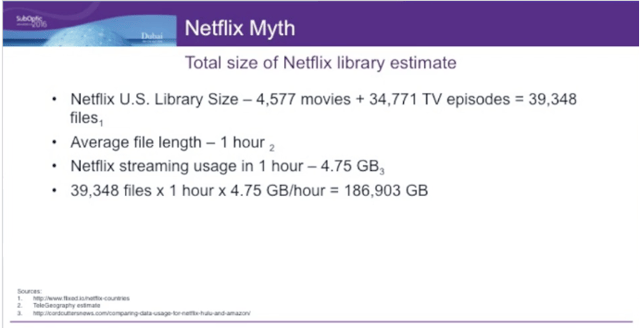Besides sharks eating undersea cables, one of the biggest myths that I’ve seen recently is Netflix being cited alongside Google, Facebook, and Microsoft as a contributor to new submarine cable investment.
Netflix certainly does account for a massive amount of end-user traffic in some regions. For example, Netflix accounts for almost a third of downstream traffic in North America according to a study from Sandvine.
Given the size of Netflix’s movie and television catalog and worldwide expansion, what sort of international bandwidth requirements do they have? According to Netflix’s blog, they transfer a copy of each file in their library from the U.S. to foreign storage location one time during off-peak hours.
That file is copied to other sites in the country using various caches using their Open Connect platform. Further, Netflix says that Open Connect delivers 100 percent of their traffic.
That being said, we know content still needs to get to the caches. When we gather data on Netflix’s library size, file length, and average streaming rate, it’s possible to create a rough estimate of bandwidth required to refresh the entire U.S. library of content each month. (I tackled this issue as part of a presentation at the 2016 Suboptic conference, which you can watch here.)

So how much file storage does Netflix’s catalog require?
Let’s say that Netflix maintains 40,000 titles, and let’s further say that the average length of those titles is one hour. (Netflix provides a lot of two-hour movies, but also a lot of 30-minute TV shows.) Finally, we have data that indicates the average Netflix user consumes 4.75 GB of data per hour. Putting all that together, we can estimate that Netflix’s U.S. library is approximately 190,000 GB.
Great. But how do we translate that number (190,000 gigabytes of data) to traffic? To make that calculation, let’s make a few simplifying assumptions. First, let’s pretend that Netflix fully refreshes its entire cache each month. Second, let’s say that Netflix does this refresh evenly over the course of 30 days in the month. That translates to 6,333 GB per day…which turns out to be a piddly 577 Mbps. If Netflix were to push this content to its caches only during a daily 12-hour off-peak period, the required capacity would be double: 1.2 Gbps.
That’s not actually too much bandwidth. Given these requirements, Netflix would only need a string of 10 Gbps links to connect its caches around the world. That’s a lot more bandwidth than you have coming to your house, but its microscopic compared to the many terabits per second that the really big content and cloud providers need internationally.
The key here is that Netflix’s library is relatively static. There’s only so much content that Hollywood, Bollywood, and Netflix themselves can crank out. By contrast, YouTube users are adding hundreds of hours of important, groundbreaking videos each minute.
For argument’s sake, let’s say caches didn’t exist and Netflix served all videos from the U.S. to subscribers in the U.K.
We know that in 2015 there were 4.3 million Netflix subscribers in the UK. According to Netflix, we also know that the maximum ISP streaming rate was 4.03 Mbps.
If all UK subscribers watched Netflix at the same time, it would require a whopping 17.3 Tbps of bandwidth. While that might be undersea cable-worthy, it’s safe to say that caches have saved the day. While Netflix does maintain an international network, its content distribution network does the heavy lifting.
Alan Mauldin
Alan Mauldin is a Research Director at TeleGeography. He manages the company’s infrastructure research group, focusing primarily on submarine cables, terrestrial networks, international Internet infrastructure, and bandwidth demand modeling. He also advises clients with due diligence analysis, feasibility studies, and business plan development for projects around the world. Alan speaks frequently about the global network industry at a wide range of conferences, including PTC, Submarine Networks World, and SubOptic.





